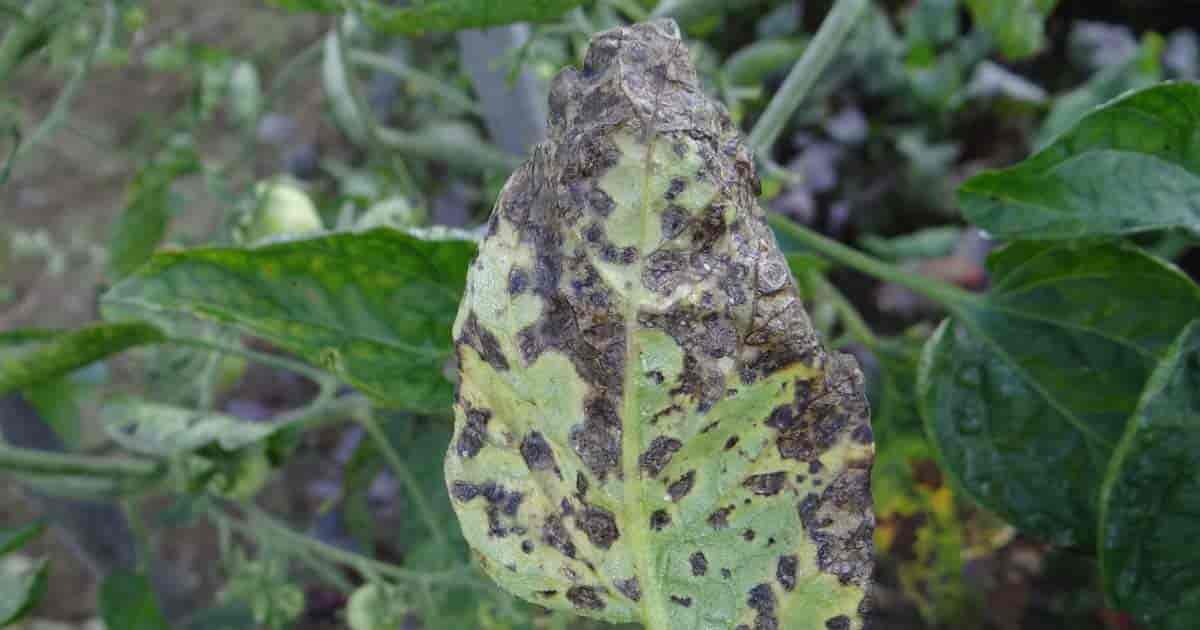Alternaria leaf spot sometimes referred to as early blight is a condition that can affect a wide variety of plants in the garden.
Various fungal pathogen species cause Alternaria.

Different species affect different types of plants, but overall, the various species of Alternaria fungus cause widespread damage to:
- Cruciferous vegetables such as: Brussels sprouts, cabbage, broccoli, cauliflower, Chinese cabbage, rutabaga, kale, kohlrabi, turnips and sometimes radishes are said to have “Alternia Spot.“
- Potatoes, peppers, tomato plants (problems and other members of the hemlock family are afflicted with “Early Blight.”
- Squash, pumpkins and melons of all kinds develop “Alternaria Leaf Spot”.
- Onions and garlic Alternaria attack is called “Purple Blotch”.
- Cucurbits (cucumbers) also develop “Alternaria Spot”.
The pathogens also affect a wide variety of herbaceous flowering plants.
Related: How To Preserve A Carved Pumpkin
How To Tell If Alternaria Fungi Have Attacked Your Plants?
The disease symptoms caused by this pathogen vary slightly from host-to-host. However, they are similar enough to be recognizable on any plant.
On most plants, you’ll notice larger dark brown or black spots developing on older leaves.
The spots may be either angular or circular, and continue growing larger until they reach a size of about a half an inch across.
Soon after this, they begin to develop dark-colored, concentric bridges or rings. Damage caused by the Alternaria pathogen sometimes looks like a target.
On chrysanthemums and tomatoes, you’ll see spots made up of concentric rings.
On various species of calendula plants, you’ll see tiny purplish/red spots.
The growth of lesions usually affects soft leaf tissue. It may not be able to eat through large veins in the leaves.
Unless stopped in its tracks, the fungus causes leaves to become yellow and withered. Soon they drop off the plant altogether.
How To Be Sure Alternaria Is Causing The Damage?
One way to tell that the leaf spots are caused by fungal infection is that the spots are often covered with velvety, dark-colored spores (conidia).
Damage caused by Alternaria fungus is not just limited to leaves. It may also cause lesions on potatoes underground.
Additionally, it can cause rotten spots around tomato plant stems. These lesions, too, are often filled with conidia spores.
Where Does This Alternaria Leaf Spot Fungus Come From?
The life cycle of the fungal pathogen can overwinter and survive for long periods in infected plant debris left on the surface of the soil.
It can also survive when buried under the soil, or borne on seed.
In the springtime, the fungal spores can blow from infected plants to healthy plants in the wind.
Additionally, they can travel in water splashed up from infected debris on the ground.
Spores may also thrive and multiply during periods of very high humidity, long rainy seasons and heavy dew.
The temperature most conducive to fungal spore growth and reproduction ranges from 65° to 73° degrees Fahrenheit.
What Can You Do About Alternaria Infection?
An integrated pest management solution of “Prevention” is the best cure for this problem.
- Rotate crops annually
- Keep the ground clean of debris
- In between crops, till the soil regularly to turn it so the fungus does not have a chance to grow and reproduce underground.
Although these pathogens can overtake entire crops and cause a great deal of damage, they are quite weak.
Keeping your crops healthy by:
- Providing the type of soil and conditions they need
- Fertilizing regularly
- Limiting insect damage will help them resist infection.
- Space plants far enough apart to provide good air circulation and reduce leaf wetness.
- Don’t allow fruit to hang heavy on your plants.
- Frequent harvesting helps prevent fungal growth.
If all else fails, talk with your county agent about an appropriate chemical control fungicide to treat the species of pathogen you are battling.
Details such as the type of crop grown, the condition of the soil, along with the species of the pathogen will affect the kind of fungicide appropriate for use and control.
